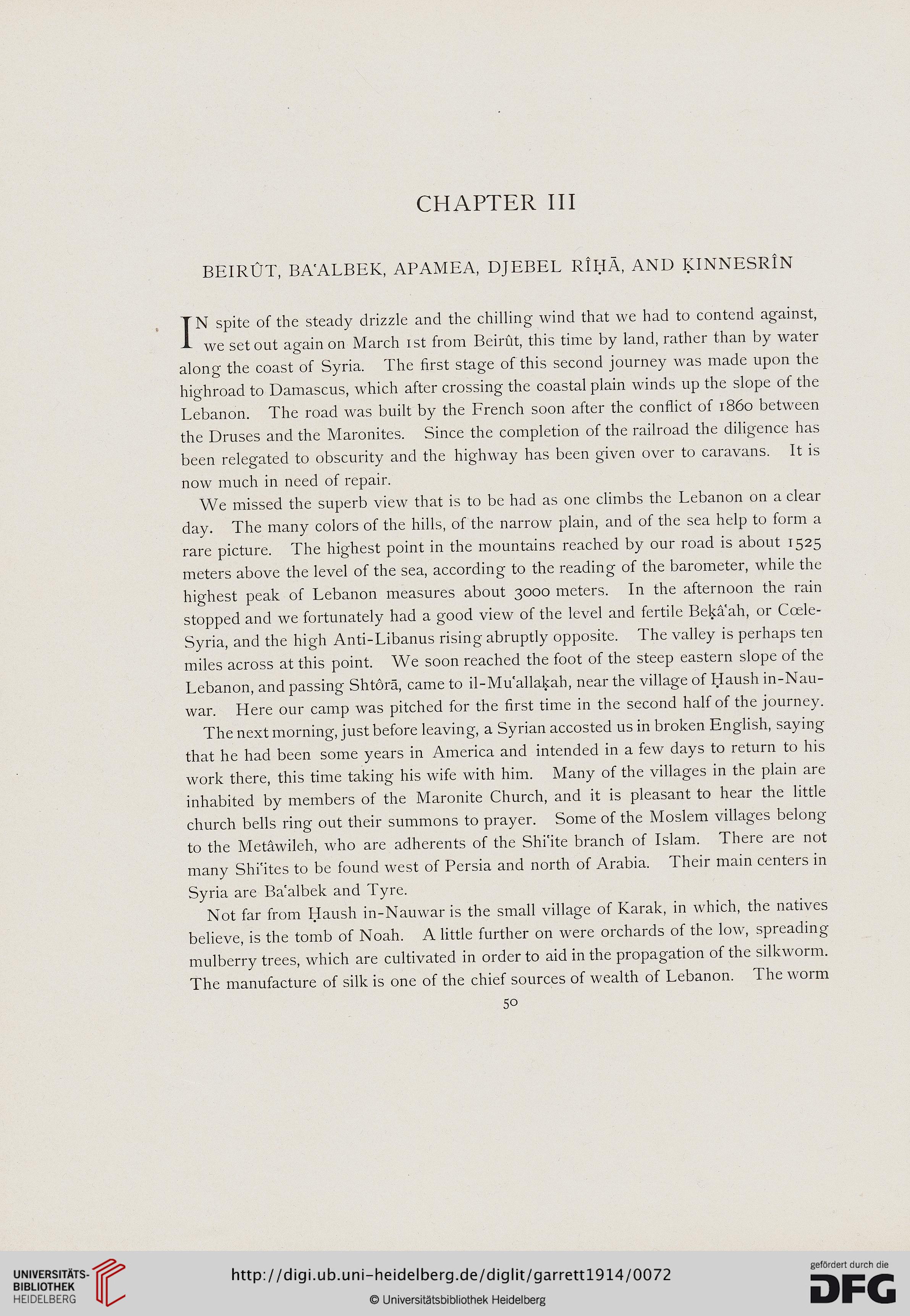CHAPTER III
BEIRUT, BA'ALBEK, APAMEA, DJEBEL RiHA, AND KINNESRIN
TN spite of the steady drizzle and the chilling wind that we had to contend against,
^ we set out again on March ist from Beirut, this time by land, rather than by water
along the coast of Syria. The first stage of this second journey was made upon the
highroad to Damascus, which after crossing the coastal plain winds up the slope of the
Lebanon. The road was built by the French soon after the conflict of i860 between
the Druses and the Maronites. Since the completion of the railroad the diligence has
been relegated to obscurity and the highway has been given over to caravans. It is
now much in need of repair.
We missed the superb view that is to be had as one climbs the Lebanon on a clear
day. The many colors of the hills, of the narrow plain, and of the sea help to form a
rare picture. The highest point in the mountains reached by our road is about 1525
meters above the level of the sea, according to the reading of the barometer, while the
highest peak of Lebanon measures about 3000 meters. In the afternoon the rain
stopped and we fortunately had a good view of the level and fertile Bekaah, or Ccele-
Syria, and the high Anti-Libanus rising abruptly opposite. The valley is perhaps ten
miles across at this point. We soon reached the foot of the steep eastern slope of the
Lebanon, and passing Shtora, came to il-Mu'allakah, near the village of Haush in-Nau-
war. Here our camp was pitched for the first time in the second half of the journey.
The next morning, just before leaving, a Syrian accosted us in broken English, saying
that he had been some years in America and intended in a few days to return to his
work there, this time taking his wife with him. Many of the villages in the plain are
inhabited by members of the Maronite Church, and it is pleasant to hear the little
church bells ring out their summons to prayer. Some of the Moslem villages belong
to the Metawileh, who are adherents of the Shi'ite branch of Islam. There are not
many Shi'ites to be found west of Persia and north of Arabia. Their main centers in
Syria are Baalbek and Tyre.
Not far from Haush in-Nauwar is the small village of Karak, in which, the natives
believe, is the tomb of Noah. A little further on were orchards of the low, spreading
mulberry trees, which are cultivated in order to aid in the propagation of the silkworm.
The manufacture of silk is one of the chief sources of wealth of Lebanon. The worm
50
BEIRUT, BA'ALBEK, APAMEA, DJEBEL RiHA, AND KINNESRIN
TN spite of the steady drizzle and the chilling wind that we had to contend against,
^ we set out again on March ist from Beirut, this time by land, rather than by water
along the coast of Syria. The first stage of this second journey was made upon the
highroad to Damascus, which after crossing the coastal plain winds up the slope of the
Lebanon. The road was built by the French soon after the conflict of i860 between
the Druses and the Maronites. Since the completion of the railroad the diligence has
been relegated to obscurity and the highway has been given over to caravans. It is
now much in need of repair.
We missed the superb view that is to be had as one climbs the Lebanon on a clear
day. The many colors of the hills, of the narrow plain, and of the sea help to form a
rare picture. The highest point in the mountains reached by our road is about 1525
meters above the level of the sea, according to the reading of the barometer, while the
highest peak of Lebanon measures about 3000 meters. In the afternoon the rain
stopped and we fortunately had a good view of the level and fertile Bekaah, or Ccele-
Syria, and the high Anti-Libanus rising abruptly opposite. The valley is perhaps ten
miles across at this point. We soon reached the foot of the steep eastern slope of the
Lebanon, and passing Shtora, came to il-Mu'allakah, near the village of Haush in-Nau-
war. Here our camp was pitched for the first time in the second half of the journey.
The next morning, just before leaving, a Syrian accosted us in broken English, saying
that he had been some years in America and intended in a few days to return to his
work there, this time taking his wife with him. Many of the villages in the plain are
inhabited by members of the Maronite Church, and it is pleasant to hear the little
church bells ring out their summons to prayer. Some of the Moslem villages belong
to the Metawileh, who are adherents of the Shi'ite branch of Islam. There are not
many Shi'ites to be found west of Persia and north of Arabia. Their main centers in
Syria are Baalbek and Tyre.
Not far from Haush in-Nauwar is the small village of Karak, in which, the natives
believe, is the tomb of Noah. A little further on were orchards of the low, spreading
mulberry trees, which are cultivated in order to aid in the propagation of the silkworm.
The manufacture of silk is one of the chief sources of wealth of Lebanon. The worm
50




